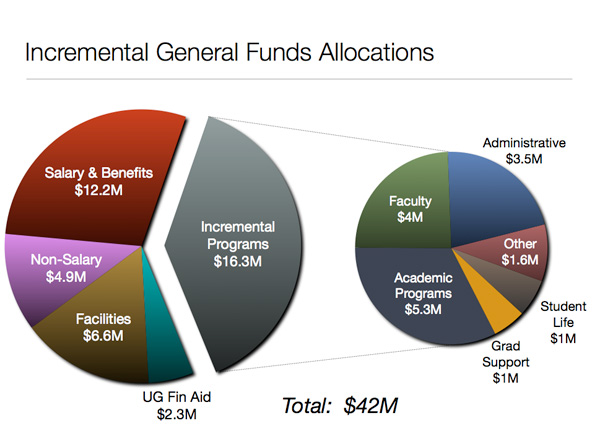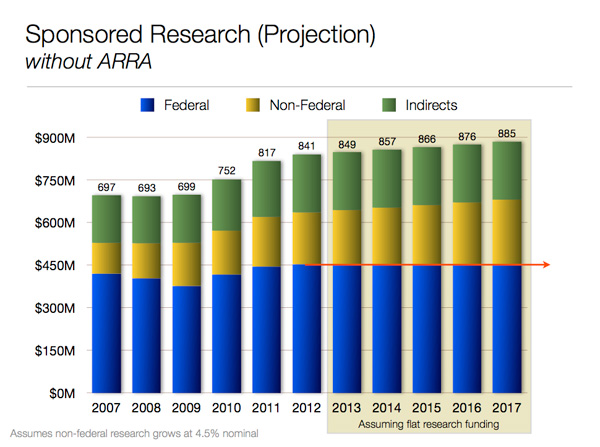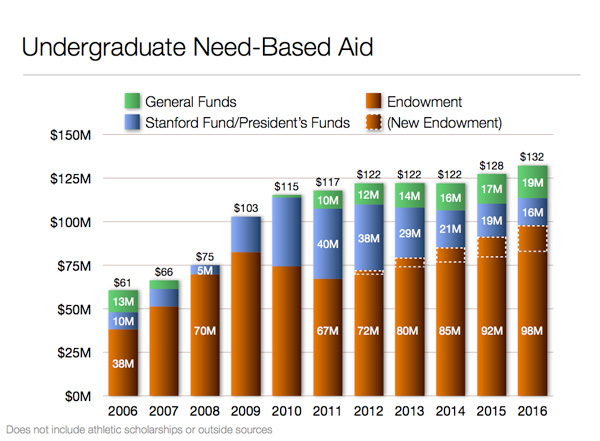Etchemendy presents optimistic budget outlook for 2012 to Faculty Senate
It's a "boring budget," and that's the good news, Provost John Etchemendy told the Faculty Senate in his presentation on the 2012 budget.
Provost John Etchemendy announced Thursday that Stanford is projecting a surplus of $203 million on $4.1 billion in revenue in its consolidated budget for operations – the overall budget of the entire university – in fiscal 2012, which begins Sept. 1.
"It's a good bottom line," he said at the beginning of his 50-minute presentation to the Faculty Senate about the university's 2011/12 budget plan.
Prior to the provost's talk, Karen Cook, vice provost for faculty development and diversity, presented an overview of the Report on the Faculty: Professorial Gains, Losses and Composition.
Cook, the Ray Lyman Wilbur Professor in the Sociology Department, presented more than a dozen slides from the report, which provides a demographic breakdown of the faculty by gender, race/ethnicity, school and faculty line. A full story on her presentation will appear in Tuesday's Stanford Report.
Also at Thursday's meeting, David Spiegel, chair of the Faculty Senate and the Jack, Samuel and Lulu Willson Professor in Medicine, announced the results of the recent senate election: Rosemary Knight, the George L. Harrington Professor in the School of Earth Sciences, will serve as chair of the 2011/12 Faculty Senate, and Russell Berman, the Walter A. Haas Professor in the Humanities, professor of comparative literature and a senior fellow at the Hoover Institution, will serve as vice-chair.
The 2012 budget plan
Etchemendy said revenue growth over the last two years was "a very good sign of a healthy recovery of the university's financial situation."
The recovery is not complete, he added, noting that the 2012 endowment payout amount will be 12 percent below the peak of the endowment payout of 2009.

The general funds budget is an essential part of the consolidated budget, because the money can be used for any university purpose, and those funds support the necessary administration and infrastructure for all core activities at Stanford. (Click to enlarge)
"We're not completely recovered, but we're doing pretty well," he said.
Etchemendy said the main cloud gathering on the horizon was the federal research budget, which is expected to remain flat for the next five years.
While Stanford has benefited significantly over the last two years from federal grants awarded under the American Recovery and Reinvestment Act (ARRA) of 2009, that funding will end in 2012, he said.
"So I decided to ask what will happen if the federal research budget remains flat for 5 years – and, very importantly, our share remains the same," he said. "I say that's very important, because historically, Stanford's share of the federal research budget has actually tended to increase in tight budget times. So I asked what's going to happen to graduate students, postdocs, indirect cost recovery and the rest of us if federal research funding remains flat."
Etchemendy devoted a significant portion of his presentation to answering those questions, using more than a dozen slides that approached the question from many different angles.
He said the effects in the graduate student population should be largely limited to the number of PhD students at Stanford. The university should be able to maintain the current size of the doctoral candidate population, because Stanford will be able to counteract the drop in federal research dollars with a mix of other funds, he said.
"We will see a leveling of some sort to the PhD population, rather than continuing growth," he said.
However, the population of postdoctoral scholars will probably decline, because the bulk of their funding is tied to federal research monies, he said.
"That is not going to affect individual postdocs who are currently employed by the university – let me make sure you understand that," Etchemendy said. "What I am saying is that as new postdocs are hired, the overall population will probably decline."
He didn't have time to talk about the capital plan at Thursday's senate meeting.
"The capital plan is chapter four in the book in front of you," Etchemendy said, referring to the 122-page, spiral-bound book, Stanford University Budget Plan 2011/12, which was distributed at the meeting.

Provost John Etchemendy said the main cloud gathering on the horizon was the federal research budget, which is expected to remain flat for the next five years. (Click to enlarge)
"I do recommend you take a look at the book. It's an amazing font of information about this university. It's actually unlike anything any other university produces. It's really worth looking at."
Stanford University Budget Plan 2011/12
In developing the 2012 budget, Stanford was guided by four principles, Etchemendy wrote in the executive summary of the budget plan:
- Avoid adding back expenses that were cut over the prior two years, with the exception of faculty positions.
- Maintain the university's highly competitive salary and undergraduate financial aid programs.
- Make modest investments in Stanford's most compelling areas.
- Maintain general funds surpluses to protect against future income shortfalls and to remain well positioned for future opportunities.
The first chapter of the plan is devoted to the consolidated budget for operations, which comprises all of Stanford's anticipated operating revenues and expenses.
The second chapter provides budget overviews for each of Stanford's 13 academic units, including the seven schools, the offices of the vice provosts for research, undergraduate education and graduate education, Hoover Institution, Stanford University Libraries & Academic Information Resources, and SLAC National Accelerator Laboratory.
The third chapter described the budgets of administrative and auxiliary units, and the final chapter outlines the 2012 capital budget and the three-year capital plan.
Consolidated budget for operations
The consolidated budget includes all of Stanford's anticipated operating revenue and expenses for fiscal 2012, except for the hospitals, which are separate corporations. While the budgets for Stanford Hospital & Clinics and Lucile Packard Children's Hospital are not included in the university's budget plan, they are included in the Stanford Annual Report.
In fiscal 2012, which begins Sept. 1, Stanford is expecting a surplus of $203 million on $4.1 billion in revenues, $3.8 billion in expenditures and $104 million in transfers.
In fiscal 2011, which ends Aug. 31, Stanford is expecting a surplus of $141 million on $4 billion in revenues, $3.7 billion in expenditures and $181 million in transfers.
Consolidated budget revenues
In 2012, sponsored research is expected to account for the largest share (29 percent) of consolidated revenues, followed by total investment income (24 percent), student income (18 percent) and healthcare services (13 percent).
Revenue from sponsored research in fiscal 2012 is projected to be $1.213 billion, compared with $1.234 billion this year. The 2012 total for sponsored research includes $650 million for university research and $346 million for SLAC, as well as $217 million in reimbursement for indirect costs incurred by Stanford in support of federal research projects. Except for fiscal 2009, when the endowment was at its peak, sponsored research has long been Stanford's largest source of revenue.

The 2012 endowment payout amount will be 12 percent below the peak of the endowment payout of 2009, Etchemendy said. (Click to enlarge)
Revenue from total investment income – endowment payout to operations and other investment income – in fiscal 2012 is projected to be $986.5 million, compared with $915.6 million this year.
Revenue from student income in fiscal 2012 is projected to be $722 million, compared with $694 million this year.
"Increases in student charges for next year were guided by a number of considerations: our programmatic needs, the effectiveness of our financial aid program, the impact of the economy on the families of our students and our pricing position relative to our peers," the budget plan said.
Revenue from healthcare services in fiscal 2012 is projected to be $549 million, compared with $540 million this year. Most of next year's healthcare services revenue – $499 million – is paid to the School of Medicine by Stanford Hospital & Clinics and Lucile Packard Children's Hospital for physician services by its faculty.
Consolidated budget expenses
In fiscal 2012, total compensation will account for the largest share (60 percent) of expenses in the consolidated budget, followed by other operating expenses (30 percent), financial aid (6 percent) and debt service (4 percent).
The total compensation category includes faculty, staff and bargaining unit salaries, fringe benefits, tuition benefits for research and teaching assistants and other non-salary compensation, such as bonuses and incentive pay.
Total compensation is expected to rise 4 percent to $2.3 billion in fiscal 2012, compared with $2.2 billion this year.
"This increase is driven by the approved merit programs for faculty and staff, additional salary allocations for equity and retention, as well as anticipated headcount growth," the budget plan said.
Student financial aid
In fiscal 2012, Stanford expects to spend $239.5 million in financial aid for undergraduate and graduate students, compared with $232 million this year.
The university's need-based financial aid program for undergraduates is designed to ensure that a family's economic circumstances will not prevent a student from attending Stanford. The university made substantial improvements to the program in 2008 – families making less than $60,000 a year are not expected to pay tuition or contribute to the cost of room and board – and remains committed to the program.
Last year, Stanford increased the target for undergraduate financial aid in The Stanford Challenge to $300 million, up from $200 million. Etchemendy wrote in the budget plan that Stanford is "making good progress toward realizing that goal."
In 2012, Stanford estimates that undergraduates will receive $128.7 million in need-based scholarships, including $122.2 million from the university and $6.6 million from federal grants. Next year, Stanford expects to provide need-based financial aid to 3,425 undergraduates, compared with 3,380 students this year.
Graduate student support
In the budget plan, Etchemendy wrote, "support for graduate students continues to be one of the highest priorities for all of Stanford's schools."
Currently, Stanford has 8,779 graduate students.
In 2012, Stanford will provide about $315 million in financial support to graduate students, including stipends, tuition allowances, and salaries and benefits for research assistants and teaching assistants, the budget plan said.

In the budget plan, Etchemendy wrote, "support for graduate students continues to be one of the highest priorities for all of Stanford's schools." (Click to enlarge)
"We have added almost $1 million in general funds for graduate student support in the non-formula schools," Etchemendy wrote. "This allocation, combined with the budgeted increase in endowment payout, will address these needs in the coming year. However, with the federal support for graduate students still under significant pressure, the long-term funding issues for graduate students remain a source of concern."
General funds budget
Stanford is predicting a $39 million surplus in the general funds budget in fiscal 2012, and is forecasting similar surpluses in fiscal 2013 and 2014.
The general funds budget is an essential part of the consolidated budget, because the money can be used for any university purpose, and those funds support the necessary administration and infrastructure for all core activities at Stanford.
Each of Stanford's seven schools receives general funds. Administrative units are supported solely by general funds.
The main sources of general funds are student tuition, indirect cost recovery from sponsored research activity, unrestricted endowment income and income from the expendable funds pool.
Total general funds revenue in 2012 is projected to be $1 billion, of which $164 million will go to the Medical School, the Graduate School of Business, Continuing Studies and Summer Session, based on previously agreed-upon formulas. The remaining general funds revenue is controlled and allocated by the provost.
After transfers and other adjustments, the provost will distribute $861 million in general funds in 2012, including $42.2 million in incremental allocations.
Those incremental allocations will help fund salary programs ($17 million); facilities costs ($6.6 million); undergraduate financial aid ($2.3 million); faculty support ($4 million); academic programs ($5.3 million); administrative operations ($3.5 million); student life ($1 million); graduate student support ($908,000); and other allocations ($1.6 million) for energy savings programs; faculty, staff and student wellness, and another patrol deputy in the Department of Public Safety.
Within the academic programs category, the largest incremental allocation ($1.2 million) is earmarked for revamping Engineering Research Administration.
The student life category includes additional funding in 2012 for Vaden Health Center, the Student Services Center, Residential Education and Bechtel International Center – all of which are part of the Student Affairs division.
Within the faculty support category, the School of Humanities and Sciences will receive $1.5 million to help pay for one-time costs associated with hiring new faculty members, including start-up packages, moving expenses and temporary support for summer salaries. The school also will receive $1.6 million to address equity concerns among existing faculty and to be able to offer retention packages to faculty who receive outside offers. The School of Earth Sciences will receive $145,000 to support the hiring of a faculty member in a new field – geobiology.
Capital budget
The 2012 capital budget calls for $455.5 million in expenditures, compared with $368.2 this year.
The projected spending reflects only a portion of the total project costs, because most projects take more than a year to complete.
The major projects in the 2012 capital budget include:
- Bioengineering/Chemical Engineering Building ($71.3 million)
- Central Energy System Improvements ($65.9 million)
- Bing Concert Hall ($53.5 million)
- West Campus Recreation Center ($26.3 million)
- Jill and John Freidenrich Center for Translational Research ($16.6 million)
Etchemendy will present the 2012 budget plan to the Stanford Board of Trustees for their approval at the board’s June 8-9 meeting.
Minutes available next week
The full minutes of the May 26 meeting, including the question-and-answer sessions that followed the presentations, will be available on the Faculty Senate website next week.


Share This Story